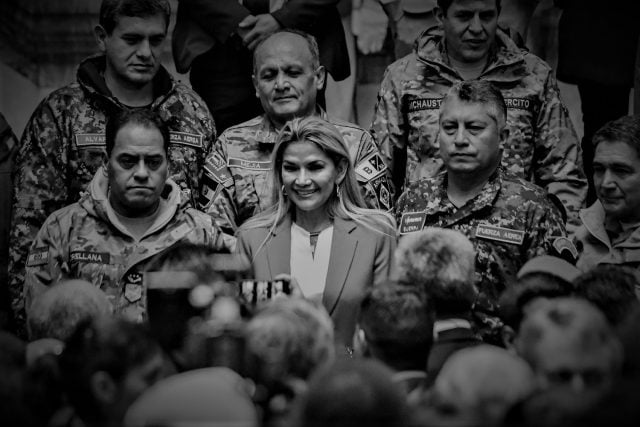During the first months of the Jeanine Áñez government, peaceful protests were violently repressed in Bolivia. The Police and the military shot unarmed protesters. Some of them were killed in summary executions. Hundreds more were injured. The persecution against opponents, attacks on freedom of the press and arbitrary arrests were massive.
There were also torture, violations of due process and sexual assaults, particularly against women. The relatives of the victims were mistreated. The detainees were forced to undress and threatened with rape or murder. The Security and Armed Forces tried to blame the protesters. They even «planted» weapons on them. The authorities hindered the investigations.
And the endemic racism loaded with hatred towards the native peoples that is historic in Bolivia was revived and promoted from the State. With the cry of «Indians full of shit!», all kinds of abuses directed mainly towards indigenous women were validated, describes a report by Cecilia González for RT.
This is the inventory of the horror suffered in Bolivia at the end of 2019. This is all detailed in the report that the Interdisciplinary Group of Independent Experts (GIEI) of the Inter-American Commission on Human Rights (IACHR) published this week and delivered to the President of Bolivia, Luis Arce, who promised that there will be justice.
The document, which is divided into eight chapters and consists of 471 pages, analyzes the human rights violations committed between the end of September and December 2019 and describes the social and political climate that preceded the presidential elections in October, which were contested. for alleged irregularities, and which led to a crisis that forced former President Evo Morales to resign on November 10.
In his place, Áñez proclaimed herself the new president with the support of the police and the military. Although the report, which will be fundamental in the judicial investigations that are already underway, does not mention the term «coup», it does describe the pressure and threats suffered by Morales and the irregularities of the inauguration of the then senator Añez.
Victims in Bolivia
The report is compelling. It states that in the last quarter of 2019 serious human rights violations were committed in Bolivia and that, in the context of a political conflict surrounded by violence, at least 37 people lost their lives in various parts of the country, while hundreds more received serious injuries, both physical and psychological.
«What happened involves the responsibility of the State for acts committed by State agents and individuals (…) the Police and the Armed Forces, separately or in joint operations, used excessive and disproportionate force», it adds.
One of the longest chapters refers to the main acts of violence and human rights violations registered throughout the country after the presidential elections of October 20. Since then, the confrontations between the ruling party and the opposition have been replicated in the cities of Santa Cruz, Cochabamba, La Paz, El Alto, Betanzos and Montero.
But the most serious cases, due to the magnitude of the use of violence and the number of victims, occurred during the first days of Áñez’s de facto presidency in the cities of Sacaba and Senkata, where massacres were committed under a decree that exempted police and military from responsibilities.
Sacaba Massacre
On the morning of November 15, 2019, the coordinator of the Six Federations of the Tropics organized a march from Sacaba to Cochabamba. The call was massive.
They were protesting the coup against Morales, they called for the defense of democracy, but they also warned against the increasing aggressions suffered by «women with skirts» (Mujeres con polleras), that is, indigenous women, and the burning of the wiphala, the flag of the native peoples despised by the Government of Áñez and its supporters.
The police stopped the protesters to prevent them from entering Cochabamba. The atmosphere became tense when a K-8 fighter plane passed in the sky. And the repression broke out. The policemen began gassing people and the military advanced. Seniors, women, boys and girls vomited and passed out.
Some took refuge in neighboring houses, but were chased and beaten out by policemen. The security forces and the military fired firearms, in some cases at the neck of the victims. The «fight» was of stones against bullets.
The balance was 10 people between 18 and 51 years old killed by gunshots. Emilio Colque León, Omar Calle Siles, Juan López Apaza, César Sipe Mérida, Lucas Sánchez Valencia, Armando Caraballo Escobar, Roberto Sejas Escobar, Plácido Rojas Delgadillo and Marco Vargas Martínez died that day.
The tenth victim, Julio Pinto Mamani, died seven months later, on June 11, 2020. The GIEI managed to document the cases of 56 injured people and 223 detainees.
Senkata Massacre
November 19, 2019 marked 12 days of peaceful blockades of protesters at the Yacimiento Petroliferos Fiscales de Bolivia (YPFB) plant in Senkata, a town in El Alto.
Then, the Police and the Army organized a joint eviction operation, supposedly to guarantee the departure of trucks and to resume the supply of fuel in La Paz, which was interrupted by the protest.
The pretext is that the protesters could blow up the plant, a risk that the GIEI report denies, which concludes that there was excessive and unjustifiable use of force, since tear gas and firearms were used, and these caused the death of 10 persons. 78 more were injured.
The human rights violations were replicated the next day, when relatives of the fatal victims and residents of El Alto organized a protest that was heading towards the center of La Paz. The procession, in which thousands of people participated, was known as «the march of the coffins» because they carried the coffins of their children, brothers and husbands who died in the Senkata repression.
For no reason, as it was another peaceful protest, the police fired tear gas at them. The victims of this massacre, who were between 22 and 37 years old, are Antonio Ronald Quispe Ticona, Clemente Mamani Santander, Calixto Huanaco Aguilario, Dedvi Posto Cusi, Edwin Jamachi Paniagua, Juan José Tenorio Mamani, Joel Colque Patty, Milton David Zenteno Gironda, Pedro Quisbert Mamani and Rudy Christhian Vásquez Condori.
Bolivia taken over by racism and religious radicalism
In addition to the massacres, the GIEI affirms that the conflict generated around the 2019 elections included a significant component of discrimination, intolerance and racial violence that rekindled a historical and structural identity problem in Bolivia.
The working group emphasizes in different passages of the report the importance of the responsibility shared by the political leaders who encouraged or tolerated the violence exercised by their respective sympathizers, to which was added the ineffective intervention of the State.
«This polarization prompted two trends: the stigmatization of the indigenous, peasant, rural, poor or dark-skinned population as sympathizers of the MAS, and the incorporation of a religious ideology into the opposition political movement», it says.
The use of the Bible and religion – it warns – played an important role in justifying the divine cause of the movement against Morales and fostered an anti-indigenous idea that seeks to restore the prominence of Catholicism in public life.
Reparation of damages
The report concludes with some thirty recommendations, among which the design of a comprehensive care and reparation plan for victims that includes an accurate census, as well as the promotion of public events to recognize their dignity and also State responsibility over the human rights violations stands out.
In that sense, in the historic event on Monday in which he formally received the document, President Luis Arce already apologized to the victims on behalf of the State, mentioned the deceased and led a minute of silence in their honor.
On the other hand, the GIEI emphasizes in several passages the need to support and accompany civil society initiatives to commemorate and preserve the memory, but without imposing unique versions and, above all, without reinforcing polarization and recognizing that there are people affected in both sides of the political spectrum and that the situation of each one of them demands recognition of their status as victims.
«A process of recomposition of the social fabric cannot be conceived without abandoning the idea that the victims are those of our political identity, while those identified with the adversary are less so or do not require attention», it warns.
It also underlines the need to strengthen the functioning of the Justice system, with full independence with respect to other powers, and to investigate crimes seriously, effectively, exhaustively, diligently, respecting due process and the rights of victims, persons charged and prosecuted.
It also recommends that the Public Ministry agree, in the short term and with the support of international cooperation, specialized working groups in each department of Bolivia to investigate the events that occurred during the 2019 crisis.
To prevent the repetition of these cases, it suggests the creation of an independent mechanism to monitor the use of force and the actions of security institutions in the context of demonstrations and social protests, as well as the adoption of precise, comprehensive and transparent protocols and regulations.


